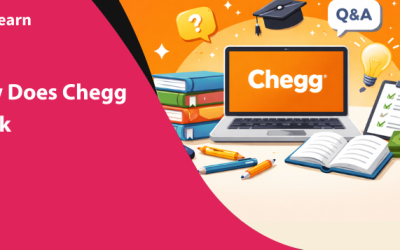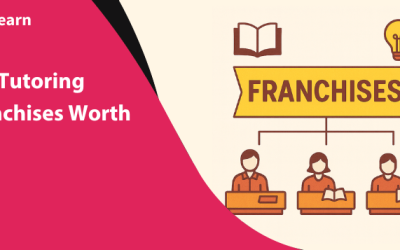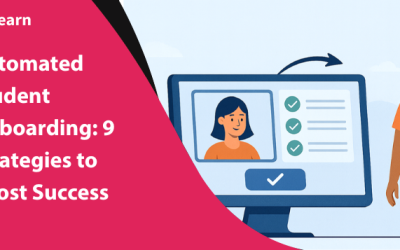How to Sell High Ticket Courses: A Complete Guide
Struggling to make a profit with low-priced courses? Then, selling high ticket courses could be your honey pot to draw a six-figure income as a creator! Apart from the big bucks, offering value and establishing authority captivates creators into the web of high-ticket sales!
However, traversing through the gossamers of this high-revenue strategy comes with its own set of challenges! From convincing high-ticket clients and high stakes involved to longer sales cycles, there’s much to live through before you revel in the sweet taste of success!
So, is there a golden sales strategy on how to sell high ticket courses? Let’s find out!
You’ll learn the following in this blog:
- What is a High-Ticket Course?
- Difference Between a High-Ticket Course and a Regular Course
- How to Sell High Ticket Courses in 7 Steps
- Sales Funnel Strategy to Draw Clients
And yes, we end it with practical tips to make your first high-ticket course pitch!
What is a High-Ticket Course?
Before we deep dive into how to sell high ticket courses, let’s understand what exactly a high ticket means!
A high-ticket course offers high value and generates around four figures or more. The premium price tag is worth considering the golden mine of knowledge it offers! These courses are typically $1,000 or more.
You could sell a high-ticket weight loss course or a digital marketing course that dispels the SEO truth to rule the search engine!
These courses swear by the formula: “Big transformations need huge investments”!
How Does High-Ticket Courses Differ From Low-Ticket Courses?
High-Ticket Vs. Low-Ticket Courses
Now you know the exact meaning of high-ticket courses!
But how do high-ticket courses differ from the low-ticket ones?
We know that high-ticket courses make you profit and often demand detailed research to teach the A-Z stuff! But there’s more to it!
So, are high-ticket courses a good bet? Here’s a sum of both course models:
| Low-Ticket Courses | High-Ticket Courses |
| Priced below $1,000 | Priced above $1,000 |
| Low profit margins, compensated with high-volume | Provides high-profit margins |
| Broader audience reach due to the low-price bar | Sold to specific clientele |
| Doesn’t require much of sales involvement | Requires getting into sales calls. |
| Need more customers to reach the sales target. | Need few elite customers to reach the sales target. |
| Don’t require group coaching and community. | Requires group coaching and community. |
| Ideal for High Volume Consumers & Low Purchasing Power. | Ideal for Low Volume Consumers & High Purchasing Power. |
| Usually, it doesn’t offer personalized enrollment and support. | Demands personalized enrollment and personalized support. |
| Promoted through discounts and promotions | Promoted through personalized enrollment and personalized support |
Skills for High-Ticket Closing
So, what does it take to be a high-ticket closer?
From crafting personalized experiences, steering with in-depth research, and handling objections, you need to offer an extra something!
Given below are the core skill-sets to be a high-ticket closer:
- Active Listening
- Empathy
- Positive Mindset
- Product Mastery & Industry Expertise
- Objection Handling Skills
- Confidence
- Adaptability
- Time Management
- Decisiveness
How to Sell High Ticket Courses: 7-Easy Steps
Selling your first high ticket course is a delicate dance between understanding your target audience, thorough research, and strategizing the right price point!
Let’s quickly move on to the detailed step-by-step guide to sell high ticket courses!
Step 1: Picking the Right Topic
The first step to crafting a high-ticket course starts with finding a profitable course topic.
There are tons of Googleable topics online; you can find answers to them with a single click! So, why would people pay a hefty price to buy your course?
Yes, they would, if your course topic is — transformational!
For example, if you pitch with a basic offer like “How to lose weight in 2 weeks?”
People can easily google it to find answers.

You need a unique selling proposition like — How to lose dad bods and drop 20 pounds in 12 weeks?
So, the breakthrough step is to have a clearly established niche and unique topic. Analyze your skills, your existing courses that are popular enough, and a relevant problem gap in your niche.
You would certainly come across your million-dollar idea!
Step 2: Performing Market Research
Now that you’ve identified a lucrative idea for building your course, it’s time to head into deep research!
It begins with building your ideal client persona. For this, you need to understand your niche marketplace thoroughly. While creating your detailed persona, research a specific group of people “to the T.” Look into their key demographics; that’s how you can craft an offer that resonates with your clients!
Ask questions like:
- Where does my target audience live?
- What drives them — specific passion, interests, skills?
- What are their goals and aspirations?
- Are there any specific challenges they are enduring?
- Which are the social platforms they typically hang out on?
Remember, it takes time to create a detailed persona. Revisit and keep refining it over time.
And yes, you can’t complete your research without competitor analysis. A bit of spying sure doesn’t hurt! Scour through other niche-related courses, coaching programs, workshops, etc.
Step 3: Creating Your Transformative Curriculum
Now, it’s time to transform your research into actual content that will catalyze the change your clients desire!
However, the first step is to create a course outline for your high-ticket program.
Map the zero-to-hero transformation and list the things required to achieve the outcome.
Remember, each client is unique, so designing your offer doesn’t mean gathering information from the internet and packaging it into a course!
You must provide a personalized and actionable plan to help your clients achieve their goals! Provide practical insights from your past experiences and case studies you know. Break the tasks into digestible modules and offer feedback through calls, chats and support groups.
Step 4: Pricing Your High-Ticket Course
Now, it’s time to talk numbers.
Most high-ticket courses are priced above the $900-$1000 range, which is a good starting point for pricing them.
The key indicator factor of pricing your program is the outcome of your course.
Consider the following factors while pricing your high-ticket courses:
- Perceived value it offers your clients
- Competitor’s pricing range
- Time and effort you invest in research
- Premium resources you offer within your course
Although high-ticket courses are always priced at a higher end, make sure you don’t overdo it. Ensure your price point aligns with the end result your clients get. If you’re aiming for a higher price point include bonuses like personalized support, coaching calls, or other upsells (ebooks or templates).
Tips on Pricing Right
- Highlight your USP
Promote your pricing point with what helps your course stand apart.
- Include Social Proof
Showcase testimonials and case studies that demonstrate customer success
- Leverage Deals and Offers
Increase perceived value with time-sensitive deals or limited seats. Build credibility with performance-based guarantees.
Step 5: Choosing a Platform to Launch Your High-Ticket Course
So, now you need to choose the right launchpad for your online course!
Which platform is ideal for selling your courses?
The two obvious choices are course platforms or selling courses from your own website.
Popular marketplaces like Udemy and Coursera aren’t ideal for selling high ticket courses. Courses are typically priced between $10 and $200 on these platforms.
Another alternative is all-in-one course platforms like Kajabi, Podia, Teachable, and Thinkific.
These platforms offer an easy course-builder, marketing and sales funnels, and analytics.
However, if you need complete ownership of your courses, it’s better to sell them from your website!
This way, you can direct traffic to your website and decide on the pricing and branding aspects!
Step 6: Master the Art of Handling Objections
“Everyone has a plan until they get punched in the face.” – Mike Tyson
So, how do you deal with the real-world punch-in-face moments, aka sales objections?
High ticket sales are sure to bring high profits and revenue. But it also comes with high stakes, intense pressure, and dealing with inevitable objections.
It could be the most common price-objection or “not worth the value” excuse. The first step to handling objections is to identify the objection type.
Below are the common types of objections:
- Price Objections: The client claims that the product is too expensive. “We don’t have enough budget for this.”
Solution: Demonstrate that the product’s ROI is greater than the initial investment. Use flexible payment options to make your product more affordable.
- Value Objections: Here, the clients doubt whether the product is worth its price.” Your price is too much for the product you offer.”
Solution: Use social proof like testimonials, case studies, etc. Offer money-back guarantees to prove you would deliver results.
- Trust Objections: Clients don’t trust the worth or credibility of your product. “I need to check this with another decision-maker.”
Solution: Be transparent about your product’s positive points and limitations.
- Urgency Objections: Clients don’t believe there’s an immediate need to buy the product. “We don’t consider it as our priority right now.”
Solution: Show your clients what they lose if they don’t purchase the product.
Above all, “transform objections into opportunities.”
Step 7: Attracting Clients to Your Course
Marketing your high-ticket courses is obviously different from one for low-ticket courses! For instance, you cannot sell your $2,000 course to someone who cannot afford a $100 course.
So, how can you find your ideal clients?
The key is to establish a strong online presence. If you position yourself as an expert, you create enough face value to persuade clients to reach your price point.
Here are the top strategies to promote your online courses:
- Create YouTube videos to share valuable content.
- Leverage paid advertising to target your ideal clientele.
- Sell through live webinars to engage and attract your ideal clients.
- Build hype using pre-launch promotions like discounts for early sign-ups.
- Use lead magnets like how-to guides or ebooks to attract more leads.
- Promote your services through affiliate marketing.
The Ultimate Sales Funnel for Your High-Ticket Course
Now that you have mastered all the steps to sell a high-ticket course. Next, let’s discuss a high-converting sales funnel to sell your online courses!
There are several types of funnels, such as WhatsApp funnels, direct sales funnels, consultation funnels, and live webinar funnels.
But, the following sales funnel is the most effective for high-ticket course sales.
This combines the power of YouTube Advertising with automated webinars.
Let’s get into the nitty-gritty of how to nurture your leads:
1. YouTube Advertising
The first step is to create traffic from YouTube Ads. Research proves that video ads on YouTube are 84% more likely to attract users’ attention. Moreover, they have an expansive reach given the wide network of users.
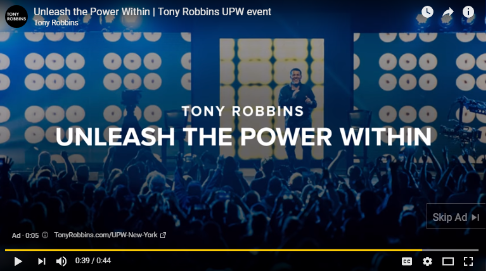
2. Lead Capture Page
Use an opt-in page to collect email addresses and build an email list. Next, you can capture leads using a registration form that prompts basic details of those interested in attending the webinar. An automated webinar is effective because you don’t need to invite clients to a specific time.
3. Host the Webinar
Now, those who have registered for the webinar attend it and gain knowledge. At the end of the webinar, you can mention the call to invite to book a session. Those who are interested are directed to an application page with relevant questions for further screening.
Record their answers, analyze it, and if it doesn’t fit your ideal persona, you can cancel their scheduled call.
So, this way your webinar leads are valuable!
Why? First off, only clients interested in learning more would register for webinars. While the prospects from lead magnets are typically interested in free gifts.
Watch this video to learn more about this sales funnel!
Tips to Sell High Ticket Courses
So, launching your first high-ticket course is crucial, and you might try hard to get it right!
Here are some do’s and don’ts to sell your high-ticket courses:
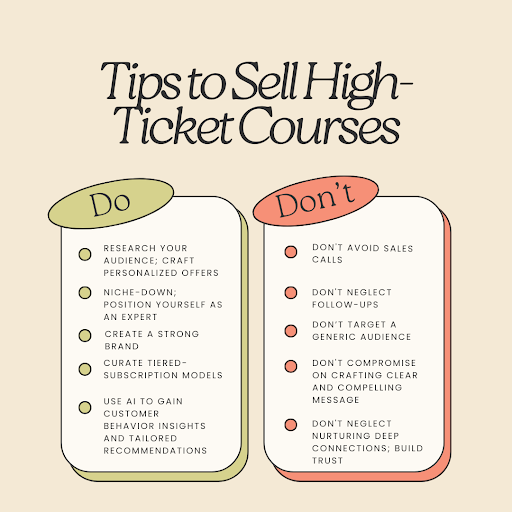
Ready to Launch Your High-Ticket Course?
So, that’s all about selling high ticket courses! You might have got detailed insights on the steps and best sales funnel to launch your first high-ticket course!
Most importantly, you need to position yourself as an expert and establish authority in your domain!
So, create and sell your high ticket course to unlock more freedom and soar your business to new heights!
FAQ-Related to How to Sell High Ticket Courses
1. How to sell high ticket courses online?
First, choose a niche for your high-ticket offer, perform in-depth research, create a transformative curriculum, choose the right price point, and market your course.
2. Is high-ticket sales hard?
Selling high ticket courses is different from standard courses due to high price points, longer sales cycles, high pressure, etc.
3. How do you land high-ticket clients?
Build a solid online presence, create blog posts addressing audience pain points, and showcase your expertise through testimonials to attract high-ticket customers.
4. How to create a high-ticket offer?
First, understand your audience, perform detailed market research, create your offer and finally, promote and sell your course.



